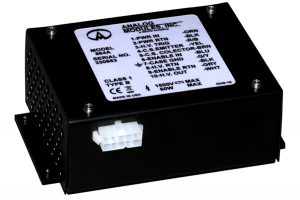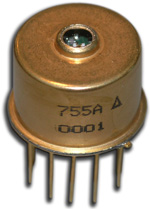Model 864A Flashlamp Simmer Supply
 The Model 864A Simmer Supply is designed to strike and maintain a low-level current discharge in flashlamps. Initially, the simmer output open circuit voltage rises to a stabilized 1500 V. The simmer trigger output provides an SCR discharge of 520 V at 63 mJ to drive a trigger transformer. When the lamp is struck, the trigger pulses are inhibited and the supply provides a constant current to the flashlamp. Immediately after PFN discharge, the current is boosted automatically to maintain the arc. An external ballast is not normally required.
The Model 864A Simmer Supply is designed to strike and maintain a low-level current discharge in flashlamps. Initially, the simmer output open circuit voltage rises to a stabilized 1500 V. The simmer trigger output provides an SCR discharge of 520 V at 63 mJ to drive a trigger transformer. When the lamp is struck, the trigger pulses are inhibited and the supply provides a constant current to the flashlamp. Immediately after PFN discharge, the current is boosted automatically to maintain the arc. An external ballast is not normally required.
■ ADJUSTABLE CURRENT TO 500 mA
■ ADJUSTABLE OPEN CIRCUIT VOLTAGE TO 1500 V
■ AUTOMATIC BOOST TO MAINTAIN ARC
■ UP TO 60 W OUTPUT
■ SCR DRIVE FOR TRIGGER TRANSFORMER
■ DIRECTIVE 2011/65/EU (RoHS) COMPLIANT
Specifications:
| Input | Voltage | +22 VDC to +32 VDC at 3 A Typical |
| Simmer Output | Voltage | Up to 300 V (depending on flashlamp) Flashlamps should be processed for simmer operation |
| Open Circuit | Up to 1500 V, ±75 V | |
| Current | Up to 500 mA | |
| Current Control | Internal multi-turn trimpot | |
| Boost Current | Up to 800 mA for 8 ms | |
| Enable | +5 V at 10 mA enables simmer, 470 Ω impedance | |
| Efficiency | 75% typical including material ballast | |
| Simmer Trigger | Voltage | -520 V pulse at 63 mJ |
| Pulse Width | ≥1 μs | |
| Repetition Rate | Automatic re-strike at ≈30 Hz, if flashlamp is not lit. | |
| Temperature | 0° to 70°C, with output current derating. | |
| Connections | Input/Output/Power | Molex, 39-01-2101 Mating Molex, 37-01-2100 |
| Size Weight |
5.78″ x 3.75″ x 2.03″ 1.41 lbs |
Typical Part Number: 864A = Input Voltage: +22 to +32VDC
Output Current: 500mA
More information:
Model 864A Data Sheet
Model 864A Interface Description

 sales@analogmodules.com
sales@analogmodules.com 1-407-339-4355
1-407-339-4355






 Hybrid eyesafe laser rangefinder receiver is designed for laser rangefinding & surveying equipment. Compact construction is ideal for miniature applications. Fast recovery from T0 overload allows ranging to close objects without compromising long range performance. The incorporation of an InGaAs APD gives very high sensitivity with time programmed gain to minimize false targets. Operation at both 1.06 µm and 1.54 µm is possible over a wide range of pulse widths.
Hybrid eyesafe laser rangefinder receiver is designed for laser rangefinding & surveying equipment. Compact construction is ideal for miniature applications. Fast recovery from T0 overload allows ranging to close objects without compromising long range performance. The incorporation of an InGaAs APD gives very high sensitivity with time programmed gain to minimize false targets. Operation at both 1.06 µm and 1.54 µm is possible over a wide range of pulse widths.
